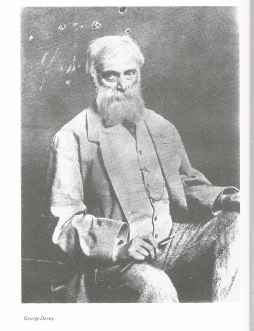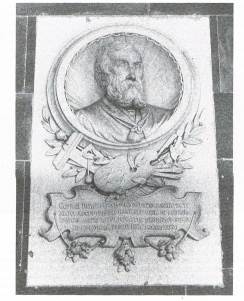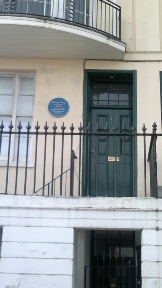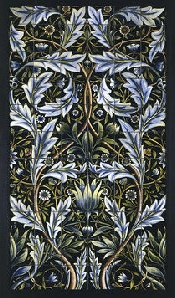Friends of Hastings Cemetery
George Devey continued

In the 1871 census we find George listed at No. 12 Pelham Crescent; he may just have been visiting his cousins, Clara Egg and her daughter.
SMIC 17/25/144 Devey, George
In 1878 he designed the Public Drinking Fountain in All Saints Street, for Francis William Staines.
Hastings News 4 April 1879 / Hastings Observer 9 April 1879
His brother Frederick moved to Hastings in 1882. Devey was thinking about retirement and moved to Hastings, where Frederick was sharing 12 Pelham Crescent with his cousins. Devey bought East Cliff House, 74 All Saints Street but did not live to move in. He set off for Ireland to discuss alterations on a Pugin mansion owned by an earl and on the journey caught a bad cold, which turned to pneumonia. He died at Hastings of bronchitis on the 4th November 1886, nursed by his cousin Clara Egg.
Although Devey never married, he proposed twice to Flora Streatfield nee Hoskins (of Chiddingstone). She refused him twice, as a spinster, and after she was widowed. She was mentioned in his will.
There is a Blue Plaque on No. 12 Pelham Crescent, Hastings
A memorial was put up by his friend Bertram Currie, who had his portrait modelled and painted in the cloister at Minley Manor in Hampshire, where Devey was working on alterations and improvements at the time of his death.


….in his sixty. sixth year, of Mr. George Devey, the architect, chiefly eminent for his skill in designing additions to and alterations of many fine old British country houses. -
His pupil, Percy Stone, at a RIBA meeting, referred to his burial “in the charmingly wooded upland cemetery at Ore, overlooking his favourite Hastings”
His entry in the Encyclopaedia Britannica says “Devey's aversion to publicity concealed his true importance, which was overlooked by architectural historians until the middle of the 20th century.”
—-

Before discussing the commission some words should be spared for Devey (1820-
His patrons were usually landed gentry, and very often bankers. One such was Edward Charles Baring (1828-
Until this text was written, Devey has not been associated with Morris, whose usual architectural contacts were Philip Webb, Norman Shaw, A.H. Mackmurdo and others in touch with the Arts and Crafts movement. However, Baring was a perceptive patron and collector of the arts, as his son, Maurice Baring, noted in his reminiscences; here, he also tells us that Membland Hall became renowned as the place of fashionable house-
...............................................................................
http://www.vam.ac.uk/content/articles/a/a-
We do get some Americans visiting on holiday (Bolton is not exactly near to London or York!!) who are astounded to find the remains of the Victorian alterations carried out by the Architect George Devey with William Morris & Co., William de Morgan and some fireplaces designed by Byrne-
The architect [George Devey] of Membland Hall in Devon commissioned this sumptuous design for bathroom tiles from William Morris (1834-
Edward Charles Baring, 1st Baron Revelstoke, was the builder of Membland Hall. He was a merchant banker. The hall was later demolished.
The commission was to decorate Membland Hall, which lay some miles north east of Plymouth. Originally the house was an 18th century one but in 1877 it was remodelled for the Baring family by George Devey.